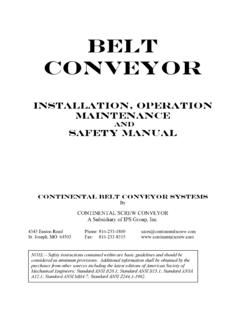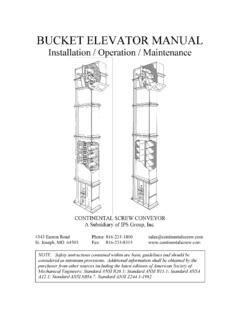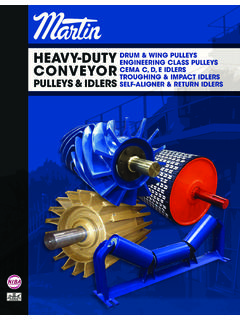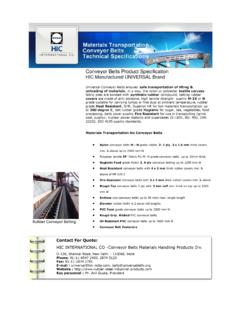Transcription of SCREW CONVEYOR MANUAL - Continental Screw
1 SCREW CONVEYOR MANUAL Installation / Operation / Maintenance Continental SCREW CONVEYOR A Subsidiary of IPS Group, Inc. 4343 Easton Road Phone: 816-233-1800 St. Joseph, MO 64503 Fax: 816-233-8315 NOTE Safety instructions contained within are basic guidelines and should be considered as minimum provisions. Additional information shall be obtained by the purchaser from other sources including the latest editions of American Society of Mechanical Engineers; Standard ANSI ; Standard ANSI ; Standard ANSA ; Standard ANSI ; Standard ANSI TABLE OF CONTENTS INTRODUCTION .. 1 SAFETY .. 2 ELECTRICAL .. 4 INSTALLATION .. 5 OPERATION .. 8 INITIAL STARTUP (WITHOUT MATERIAL) .. 9 INITIAL STARTUP (WITH MATERIAL) .. 10 EXTENDED SHUT DOWN.
2 10 MAINTENANCE .. 10 SERVICING OF COMPONENTS .. 11 STANDARDS .. 12 Continental SCREW CONVEYOR Page 1 SCREW CONVEYOR MANUAL INTRODUCTION This MANUAL contains complete instructions for the installation, operation, and maintenance of SCREW conveyors as manufactured by Continental SCREW CONVEYOR . Performance, reliability, and service life of this equipment depends to a large extent on the care taken in installing and otherwise preparing this equipment for its intended use. Most conveyors can be assembled by owners or contractors who purchased the necessary components to accommodate their own design. Many other conveyors however are purchased such that they are completely assembled, fitted, match marked, and then disassembled for shipment. Still other conveyors require Engineering drawings to describe them completely and these usually involve the fabrication of special hoppers, supports, drive equipment or other features to be with or as a part of the SCREW CONVEYOR assembly.
3 These Engineering drawings serve the dual purpose of detailing the special parts or components to be manufactured and to identify what is to be furnished for the buyer and installer. They are not to be considered design drawings for the concept of a process or system. All SCREW CONVEYOR components are manufactured to the standards of the CONVEYOR Equipment Manufacturers Association. (CEMA) Continental SCREW CONVEYOR Page 2 SCREW CONVEYOR MANUAL SAFETY CONVEYOR assemblies or components must be installed, maintained, and operated in such a manner as to comply with the Occupational Safety and Health Act, all state and local regulations, and the American National Standard Institute safety code. It is the owner/installer s responsibility to insure that this requirement is followed. GENERAL SAFETY PRECAUTIONS Taking into consideration all of the physical aspects of the installation, any or all of the following safeguards may be required to protect the operators and those working in the immediate area of the CONVEYOR .
4 1. COVERS and GRATINGS: Use rugged gratings in all loading areas and solid covers in other areas. Covers, guards, and gratings at inlet points must be such that personnel cannot be injured by the SCREW . 2. GUARDS. For protection of the operator and other persons in the working area, purchaser should provide guards for all exposed equipment such as drives, gears, shafts, couplings, etc. AS SHOWN IN THE WARNING LABEL IN FIGURE 1, DO NOT STEP OR WALK ON CONVEYOR COVERS OR GRATING OR POWER TRANSMISSION GUARDS. LOCK OUT POWERBEFORE REMOVINGCOVER OR NOT STEP ONCOVER OR GUARD.! WARNING ! FIGURE 1 Continental SCREW CONVEYOR Page 3 SCREW CONVEYOR MANUAL PRECAUTIONS FOR HAZARDOUS OPERATIONS Standard SCREW conveyors are not equipped to operate under conditions which may be hazardous, nor with hazardous materials. The manufacturer should be consulted if there is any indication that a hazardous condition or material is involved. Several situations may create these conditions, with some examples being: HAZARDOUS CONDITIONS Where the product area is under pressure or vacuum, or the trough is provided with jackets for heating or cooling, special requirements are required.
5 Consult the factory for additional information, as standard components are not designed for this service. HAZARDOUS MATERIALS These may be explosive, flammable, toxic, noxious, etc. As special provisions for safety are required, please consult the factory for additional information, as standard components are not designed for this service. HANDLING FOODSTUFFS Subjects conveyors to special codes for materials, construction, location, and/or accessibility. Investigate before ordering standard components. Food grade conveyors often require hinged access doors for inspection or drop-bottom troughs for cleaning. Special precautions should be taken for protection of personnel against contact with the SCREW . Extensive use of padlocks, with keys in the hands of management is one means frequently used. Contact the factory for additional information on other options. Continental SCREW CONVEYOR Page 4 SCREW CONVEYOR MANUAL ELECTRICAL CONVEYOR component manufacturers generally do not provide electrical equipment to control the conveyors.
6 In selecting electrical control equipment to be used with any CONVEYOR installation, the purchaser must use equipment conforming to the National Electrical Safety Code and other local or national codes. Consideration should be given to some or all of the following devices and to others which may be appropriate. 1. OVERLOAD PROTECTION: Devices such as shear pins, torque limiters, etc., to shut off power whenever operation of the CONVEYOR is stopped as a result of excessive material, foreign objects, excessively large lumps, etc. 2. NO-SPEED PROTECTION: Devices such as zero speed switches to shut off power if any incident which might cause a CONVEYOR to cease operating. 3. Safety shut-off switch with power lockout provision at CONVEYOR drive. 4. Emergency stop switches readily accessible wherever required. 5. Electrical interlocking to shut down feeding conveyors whenever a receiving CONVEYOR stops. 6. Signal devices to warn personnel of imminent start up of CONVEYOR , especially if started from a remote location.
7 7. Special limit enclosures for motors and controls for hazardous atmospheric conditions and surroundings. 8. Limit switches at cover openings. Continental SCREW CONVEYOR Page 5 SCREW CONVEYOR MANUAL INSTALLATION RECEIVING Check all assemblies and parts against shipping papers, and inspect for damage on arrival. Look for dented or bent trough and bent flanges, flighting, pipe or hangers. Minor damage incurred in shipping can be readily repaired in the field. For severely damaged parts, file an immediate claim with the carrier. Before proceeding with erection, make sure that all supplementary instructions are included. If anything is missing, consult the supplier. TOLERANCE BUILD-UPLESS THAN 3/16"C/L TROUGH JOINTC/L HANGERTHRUST ENDEND OFTROUGHSC/L HANGERUSE SHIM WHENTOLERANCE BUILD-UPIS MORE THAN 3/16"1/4" SHIM FIGURE 2 ERECTION SCREW CONVEYOR troughs must be assembled straight and true with no distortion. If anchor bolts are not in line, either move them or slot the CONVEYOR feet or saddle holes.
8 Use shims under feet as required to achieve correct alignment. Do not proceed with installation of shafts and screws until trough has been aligned and bolted down. CONVENTIONAL CONVEYOR SCREWS 1. When shipped as loose parts, assemble bearings to trough end plates. 2. If trough ends are factory assembled with trough, check bearings and seals for possible misalignment which may have occurred during shipment. Realign if necessary. 3. Place trough ends in proper sequence with discharge spouts properly located. Connect the joints loosely, without tightening the bolts. Align the trough bottom and centerline perfectly using piano wire, as shown in Figures 2 and 3. Then tighten joint bolts and all anchor bolts. 4. Begin assembly of SCREW sections, working from the thrust end. (Drive shaft and thrust bearings are normally at the discharge end to place the CONVEYOR SCREW in tension.) Continental SCREW CONVEYOR Page 6 SCREW CONVEYOR MANUAL "A ""A ""A "PIANO W IRE (STRETCH TIGHT)JO IN TANGLECLIP"A" DIM ENSIO N SHO ULD BE EQ UAL FO R FULL LENG THOF TROUGH, BOTTOM TO BE SMOOTH THROUGH JOINTS FIGURE 3 5.
9 Place the first SCREW section in the trough, fitting it onto the end shaft. Install coupling bolts. If reinforcing lugs are on the ends of flighting install SCREW so they are opposite the carrying side of the flights. 6. Insert coupling shaft into opposite end of CONVEYOR pipe; install coupling bolts. 7. If screws are not close coupled, slide hanger over coupling and bolt to trough. 8. Pull CONVEYOR SCREW away from discharge end of CONVEYOR to seat the thrust connection and remove any play in coupling bolts. FLIGHTING ENDS ALIGN TO PRODUCEA CONTINUOUS CARRYING SURFACECLOSE COUPLEDCONVEYOR SCREWSFLIGHTING ENDS ROUGHLY180 DEGREES APARTCONVEYOR SCREW COUPLINGWITH HANGERFIGURE 4 9. Place next SCREW section in trough and fit into coupling so that flighting end is about 180 degrees from end of flighting of the first section. (See Figure 4). Install coupling bolts. (For close coupled conveyors without hangers: Assemble screws so that flighting at adjoining ends of SCREW sections align to provide a continuous surface.)
10 In the case of material supplied on orders for component only the coupling bolt holes are drilled in only one end of the coupling shafts and it will be necessary to mark and drill the other end in the field. Remove shaft from SCREW before drilling; DO NOT USE SCREW PIPE AS DRILL JIG.) Continental SCREW CONVEYOR Page 7 SCREW CONVEYOR MANUAL 10. Insert coupling shaft into opposite end of pipe; install coupling bolts. Install hanger and pull out on pipe to remove any play. (See step 8) 11. Go back to hanger installed previously; center the bearing between ends of pipes, and tighten hanger mounting bolts. Revolve SCREW to check alignment. If SCREW does not turn freely, adjust hanger mountings until it does. Then proceed with installation of next SCREW section. 12. Alternately assemble SCREW sections, couplings, and hangers as in steps 9 - 11 until all but the last SCREW section has been installed. Remove the trough end to install last SCREW section.






